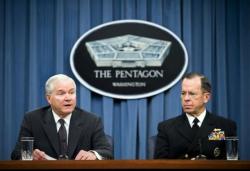
After too many leaks, the Defense Department released its quadrennial defense review (QDR). Congress mandates a periodic strategic review of the national defense strategy, force structure, force modernization plans, infrastructure, budget plan, and other elements of the defense program and policies of the United States.
The goal is to link the country’s strategy with its defense resource allocation programs. Because the military is what Congress buys, the latest version of the military’s big muscle groups probably give the best indications of what to expect from the Defense Department.
The Army will remain focused on its 73 total brigade combat teams (BCTs): 45 Active Component (AC) and 28 Reserve Component consisting of 40 infantry brigade combat teams, 8 Stryker brigade combat teams, 25 heavy brigade combat teams, 21 combat aviation brigades, 15 Patriot battalions, and 7 Terminal High Altitude Area Defense (THAAD) batteries.
The Navy remains carrier-centric with 10-11 aircraft carriers, 84-88 large surface combatants (including 21-32 ballistic missile defense-capable combatants), 29-31 amphibious warfare ships, 53-55 attack submarines, 4 guided missile submarines, 17-25 command and support vessels, and 51 roll-on/roll-off strategic sealift vessels.
The Marine Corps maintains 11 infantry regiments, 4 artillery regiments, 4 Marine aircraft wings, 4 Marine logistics groups, and 7 Marine expeditionary unit command elements.
The Air Force will have 8 ISR wing-equivalents (with up to 380 primary mission aircraft), 30-32 airlift and aerial refueling wing-equivalents, 10-11 theater strike wing-equivalents, 5 long-range strike (bomber) wings, 6 air superiority wing-equivalents, 3 command and control wings, 5 fully operational air and space operations centers, and 10 space and cyberspace wings.
And Special Operations Force will be composed of approximately 660 special operations teams, including Army Special Forces Operational Detachment-Alpha (ODA) teams; Navy Sea, Air, and Land [SEAL] platoons; Marine special operations teams; Air Force special tactics teams and operational aviation detachments; 3 Ranger battalions; and 165 aircraft.
As evident in the force composition, the military remains focused on strength because “America’s interests and role in the world require Armed Forces with unmatched capabilities and a willingness on the part of the nation to employ them in defense of our national interests and the common good."
The force also remains similar to today and is focused on similar strategic priorities Defense Secretary Gates first articulated in his 2008 defense strategy. The key mission areas are:
- Defend the United States and support civil authorities at home;
- Succeed in counterinsurgency, stability, and counterterrorism operations;
- Build the security capacity of partner states;
- Deter and defeat aggression in anti-access environments;
- Prevent proliferation and counter weapons of mass destruction; and
- Operate effectively in cyberspace.
The necessity of cooperation is echoed throughout the document because for the United States to lead “others [must] trust it to carry forward their best interests, to listen to their concerns, and to uphold the norms and values of the international community.” It is unclear whether the large force size will scare or encourage partners, but this has been a key feature for U.S. defense policy for decades.
To be sure, working with partner militaries remains a cornerstone of U.S. defense strategy. At least 150 countries receive U.S. security assistance and about 30 more rely on security cooperation with the United States. Today, Pakistan, Afghanistan, Israel, Iraq, and Colombia are at the forefront, but traditional partners like Japan, South Korea, and other NATO countries benefit too.
While working with partners is always the preferred solution to solving the United States’ security dilemmas, the force size does give the United States options that many countries in the world do not have. This is clear in the QDR:
Whenever possible, the United States will use force in an internationally sanctioned coalition with allies, international and regional organizations, and like-minded nations committed to these common principles. America’s Armed Forces will retain the ability to act unilaterally and decisively when appropriate, maintaining joint, all-domain military capabilities that can prevail across a wide range of contingencies.
While perhaps better stated than in previous documents, it is reminiscent of the Rumsfeld strategy that called for “full-spectrum dominance.” That is, the United States will maintain the ability to go anywhere (sub-surface to outer space) and control any situation (major combat to humanitarian assistance). This ambition, un-tempered by the harsh realities the United States faces in benign environments like Haiti or hostile environments like Afghanistan, seems to undermine Secretary Gates’ goal of restoring balance.
Derek Reveron, an Atlantic Council contributing editor, is a professor of national security affairs at the U.S. Naval War College in Newport, Rhode Island. These views are his own. AP Photo.
Image: GatesMullen.warsawbiopic.jpg
